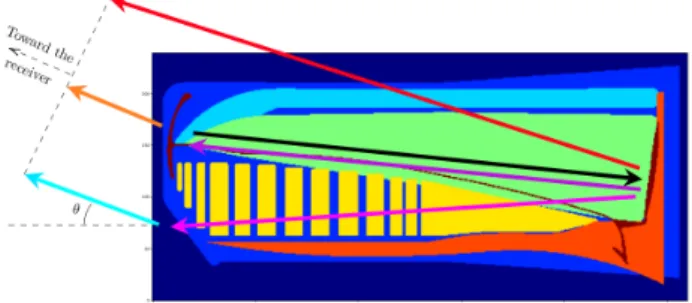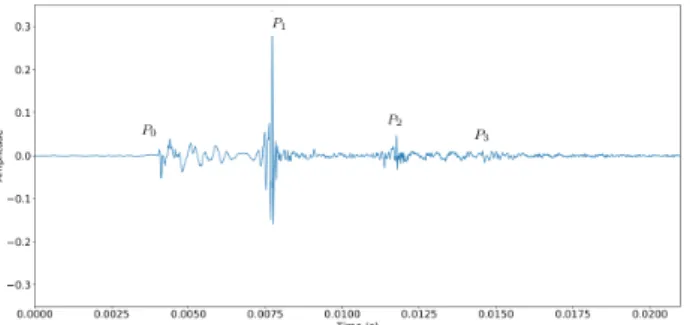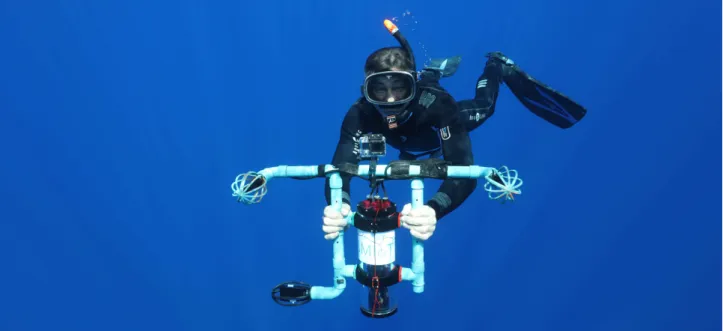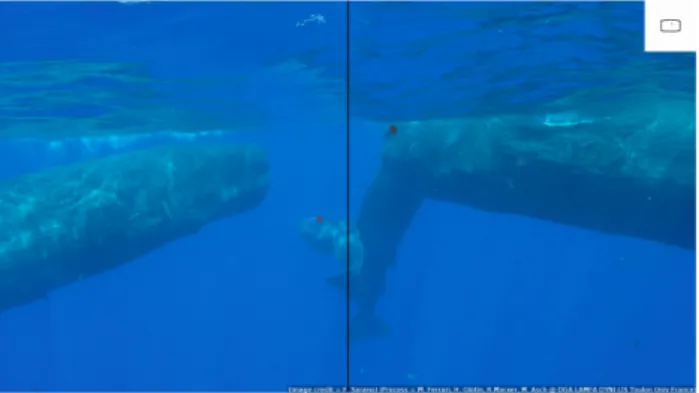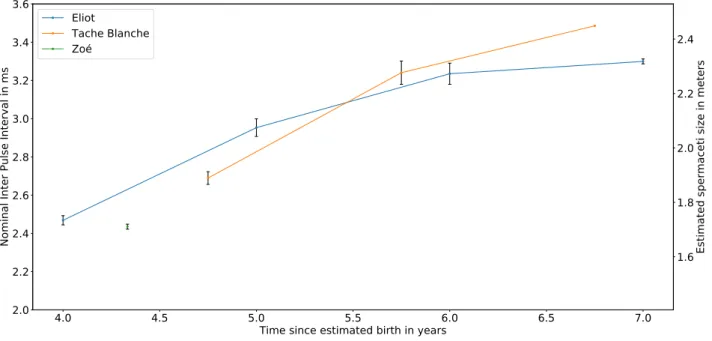HAL Id: hal-03230843
https://hal.archives-ouvertes.fr/hal-03230843
Submitted on 26 May 2021
HAL is a multi-disciplinary open access
archive for the deposit and dissemination of
sci-entific research documents, whether they are
pub-lished or not. The documents may come from
teaching and research institutions in France or
abroad, or from public or private research centers.
L’archive ouverte pluridisciplinaire HAL, est
destinée au dépôt et à la diffusion de documents
scientifiques de niveau recherche, publiés ou non,
émanant des établissements d’enseignement et de
recherche français ou étrangers, des laboratoires
publics ou privés.
3D diarization of a sperm whale click cocktail party by
an ultra high sampling rate portable hydrophone array
for assessing individual cetacean growth curves
Maxence Ferrari, Hervé Glotin, Marina Oger, Ricard Marxer, Mark Asch,
Valentin Gies, Francois Sarano
To cite this version:
Maxence Ferrari, Hervé Glotin, Marina Oger, Ricard Marxer, Mark Asch, et al.. 3D diarization of
a sperm whale click cocktail party by an ultra high sampling rate portable hydrophone array for
assessing individual cetacean growth curves. Forum Acusticum, Dec 2020, Lyon, France.
pp.3239-3243, �10.48465/fa.2020.1097�. �hal-03230843�
3D DIARIZATION OF A SPERM WHALE CLICK COCKTAIL PARTY BY
AN ULTRA HIGH SAMPLING RATE PORTABLE HYDROPHONE ARRAY
FOR ASSESSING INDIVIDUAL CETACEAN GROWTH CURVES
Maxence Ferrari
1Herv´e Glotin
1,4Marina Oger
1Ricard Marxer
1Mark Asch
2Valentin Gies
4Franc¸ois Sarano
3 1Univ. Toulon, AMU, CNRS, LIS, DYNI, Marseille, France
2
Universit´e Amiens, CNRS, LAMFA, France
3Longitude 181, France
4
SMIoT INPS Toulon, France
maxence.ferrari@univ-tln.fr, glotin@univ-tln.fr
ABSTRACT
Passive acoustics allow us to study groups of animals and obtain information that could not be gathered by other means. In this paper we demonstrate a method using an ultra high velocity portable recorder, and apply it to a set of audiovisual recordings of a Sperm whale pod. We thus localise and segregate nearly all the clicks emitted by the animals that are filmed. To our best knowledge, this is the first characterization of these vocalizations correlated to visually identified individuals. This approach allows the construction of growth curves of the biggest toothed cetacean and opens avenues to possible acoustic individual signatures.
1. INTRODUCTION
Passive acoustics allow us to study groups of animals and obtain information that could not be gathered through other methods. In this paper we study a set of audiovisual recordings of a Sperm whale pod, acquired with a specific ultra high-frequency and small aperture antenna, shown in Figure 4. This antenna is equipped with a Go-Pro video camera and the JASON DAC [1, 2], capable of recording up to 5 channels at a 2 MHz sampling rate. In this ex-periment it was set to record at 300 kHz. In 2018, the antenna had 3 hydrophones, thus increasing the number of cases that can be distinguished. This high velocity record-ing allows to reduce the size of the array, while keeprecord-ing a good angle of arrival resolution. We then demonstrate how Time Difference of Arrival (TDoA) and a nonlinear solver can produce the localisation of nearly all the clicks emitted by the animals that are filmed. To our best knowl-edge, this is the first characterization of these vocalizations correlated to individuals that have been identified visually. It allows the construction of growth curves for individual whales, and opens avenues to possible acoustic individual signatures.
Figure 1. Pulse path in the head of the Sperm whale in the leaky bent horn model. The spermaceti is in the green volume.
2. SPERM WHALE CLICK EMISSION When a Sperm whale emits a click, it propagates through the water and reaches each hydrophone at a different time. By inverting the propagation equation, it is thus possible to obtain the location of a Sperm whale relative to an acous-tic antenna [3]. The difficulty of this task resides in the estimation of the various times of arrival, and having good measurements of the speed of sound and of the shape of the antenna. Once the positions are obtained, the clicks can be clustered by individuals when locations of multiple indi-viduals are sufficiently spaced. Note that this is the case when Sperm whales are foraging. While passive acoustics alone can obtain some degree of individual labeling with this technique, the obtained labels cannot keep the ation with one individual over multiple dives. The associ-ation between multiple encounters being out of the ques-tion. The use of a video channel solves this issue since an expert can identify the same Sperm whale over multiple years using visual cues. The use of the video thus allows us to study the variation of an acoustical individual fea-ture, such as the inter pulse interval (IPI) over the years, or perform behavioural studies.
Figure 1 shows the acoustic paths that a pulse follows. After being emitted at the base of the black arrow, the pulse will bounce back and forth in the spermaceti (light green in Fig.1) according to the bent horn model [4–6]. This
bounc-Figure 2. Example of a Sperm whale click demonstrating its multipulsed structure P0, P1, P2. The nominal IPI is the time lapse between P1 to P2.
Figure 3. Franc¸ois Sarano holding the 2018 antenna near Physeters m.
ing generates the multiple pulses that form a Sperm whale click as seen in Fig.2. The nominal IPI is the time differ-ence of arrival between P2 and P1. The differdiffer-ence between P1 and P0 depends on the angle θ (see [7, 8] for details on the automatic estimation of the IPI and the effects of the angles). The nominal IPI is related to the length of the head of the individual, thus related to its body length. The length of the head function of IPI is linked to the sound celerity in the spermaceti. The extrapolation to the body size has been studied in [9–11].
3. CLICK DETECTION
The collected recordings include a cocktail party of vari-ous types of click trains from several animals as shown in Fig.5.
For this study, the clicks were detected using the Teager-Kaiser energy operator [12] after a bandpass filter. Local maxima in sliding windows of 20 ms are then extracted. Only the maxima that are above a threshold, set by a rolling median, are kept. This rolling median is used to estimate the noise level.
4. TDOA ESTIMATION AND SOURCE LOCATION In order to estimate the time difference of arrival (TDoA), we use a technique called geometric steered response power [13]. This technique improves the TDoA estimation by combining all the possible cross correlations. Since this technique does not use the shape of the antenna, some spu-rious clicks can be filtered out by using the constraints for the antenna shape [14]. Finally, using the shape of the an-tenna seen in Fig.3 and Fig.4, the TDoA and the position of the source are estimated.
5. DOA PLOTTING
Since we have the position of the source, we compute the Direction of Arrival (DoA) of the click at the position of the GoPro and compare it to its optical axis. Thus, we were able to plot the position of the source in the video [8], allowing us to know if the Sperm whale that emitted the click is present in the video or not, and which one it is (Fig.6). Some of these videos can be viewed at http:// sabiod.univ-tln.fr/pub/Sarano_2018/. The whales are then identified by Franc¸ois Sarano’s team, lead-ing to a database of Sperm whale clicks with individual la-bels over multiple years. However, some parts of this data flow are still to be fully automated, and a large part of our database still lacks this labeling.
6. CONCLUSION
This database led to multiple studies. Here we present the measurements of the nominal IPI growth of young Sperm whales over four years. To our knowledge this is the first time that IPIs are followed over four years for the same individuals.
The IPIs in Fig.7 are identified using the video record-ing where the youngs are present (Fig.6). Then for each click linked to the right individual, the IPIs were manu-ally measured [15]. We then estimate the size of the heads from these estimated nominal IPIs, for a sound celerity of 1405m/s, by assuming spermaceti temperature of 30◦C [16], (see the right axes Fig.7).
Because we know their birthdates (Tache Blanche: June 2011 ; Eliot: March 2011 ; Zo´e: December 2013), we notice they have different sizes at 5 years old, and that Tache Blanche grows faster than Eliot whereas they have the same father, and their mothers are of the same size (re-spectively Delphine and Ad´elie [17]). These differences might be due to individual and environmental conditions, such as the quality of the milk they still drink at 5 years old. Following this method, we are currently adding other individuals, juveniles and adults, that we recorded over the following years with our system. These growth curves will help to better understand the growth of Sperm whales, the biggest toothed predator at the top of the trophic chain. 1
7. ACKNOWLEDGEMENTS
We thank V. Sarano for her discussions, M. Mercier for discussions on ultra high sampled recordings, Jean-Luc
Figure 4. F. Sarano holding the antenna, version 2018, designed and built by H. Glotin (Image: F. Guerin). The hy-drophones are three Cetacean Research, at the top two CR55 spaced by 60 cm, at the bottom a CR305.
Figure 5. Spectrogram of Physeter macrocephalus, P.m. in near field measured by our system showing click trains up to 50 kHz. Stereo recording of the 14thof April 2018, at 300 kHz Sampling Rate, 16 bits, hydrophones CR57 (Cetacean Research Tech., USA). Graphic with the help of M. Mercier (TripinLab).
Figure 6. Group of four Sperm whales recorded in 2019, with two sources being pointed out (red dots): from Tache Blanche at the right, and from Alexander at the center (3 months old). Chesna is at the back-right (born 2018), Eliot is at the left (born 2011). Note that for visibility the dot stays on for 7 frames (at 25 frames per sec.). Hence two sequential click trains can be seen on the same frame, as in this example. Videos are available for viewing–see text.
Jung’s team (UBO) for the DNA analyses of mothers, fa-thers and juveniles. We thank for financial support AID French Defense Agency, Region Haut de France, gramma Interreg Italia-Francia Marittimo 2014-2020 Pro-getto GIAS, ANR-20-CHIA-0014-01 national Chair in Artificial Intelligence ADSIL (H. Glotin), and ANR-18-CE40-0014 SMILES. We thank SMIoT UTLN and INPS for soundcard co-development. This work is part of a longitudinal study directed by Longitude 181 Associa-tion under the Maubydick program initiated by Marine Megafauna Conservation Organisation. Special thanks to Label Bleu, who provided most of the video, to Navin Rishinand Boodhonee and the Blue water diving center, as well as all the ecovolunteers of MMCO. Mauritian pub-lic authorities greatly helped the Maubydick project, in particular the Mauritian Prime Minister Office, the Con-tinental Shelf, Maritime Zones Administration & Explo-ration (CSMZAE, Dr R´eza Badal and his team), the Albion Fisheries Research Center (AFRC, Chief Scientific offi-cer Mr Satish Kadhun), the Mauritius Film Development Corp. (MFDC, Mr Sachin Jootun & Mrs Eliana Timol) and the Tourism Authority (TA, Mrs Khoudijah Boodoo, ex-Director). We thank Olivier Adam’s team for joint stud-ies.
8. REFERENCES
[1] V. Barchasz, V. Gies, S. Marzetti, and H. Glotin, “Qualilife highblue: a novel smart low-power high speed and precision recorder for long term biodiversity surveys,” In Proc. of the Acustica Symposium, 2020. [2] M. Fourniol, V. Gi´es, V. Barchasz, E. Kussener,
H. Barthelemy, R. Vauch´e, and H. Glotin, “Low-power wake-up system based on frequency analysis for envi-ronmental internet of things,” in Int. Conf. on Mecha-tronic, Embedded Systems, App., pp. 1–6, IEEE, 2018.
[3] H. Glotin, F. Caudal, and P. Giraudet, “Whale cocktail party: real-time multiple tracking and signal analyses,” Canadian acoustics, vol. 36, no. 1, pp. 139–145, 2008. [4] K. S. Norris and G. W. Harvey, “A theory for the func-tion of the spermaceti organ of the Sperm whale (Phy-seter catodon),” 1972.
[5] B. Møhl, M. Wahlberg, P. T. Madsen, A. Heerfordt, and A. Lund, “The monopulsed nature of Sperm whale clicks,” The Journal of the Acoustical Society of Amer-ica, vol. 114, no. 2, pp. 1143–1154, 2003.
[6] W. M. Zimmer, P. T. Madsen, V. Teloni, M. P. Johnson, and P. L. Tyack, “Off-axis effects on the multipulse structure of Sperm whale usual clicks with implications for sound production,” The Journal of the Acoustical Society of America, vol. 118, no. 5, pp. 3337–3345, 2005.
[7] R. Abeille, Y. Doh, P. Giraudet, H. Glotin, J.-M. Pre-vot, and C. Rabouy, “Estimation robuste par acoustique passive de l’intervalle-inter-pulse des clics de Physeter macrocephalus: m´ethode et application sur le parc na-tional de Port-Cros,” Journal of the Scientific Reports of Port-Cros National Park, vol. 28, 2014.
[8] M. Ferrari, Study of a Biosonar Based on the Mod-eling of a Complete Chain of Emission-Propagation-Reception with Validation on Sperm Whales. PhD thesis, Universit´e de Picardie Jules Verne, Amiens, France, Sept. 2020.
[9] J. C. Gordon, “Evaluation of a method for determin-ing the length of Sperm whales (Physeter c.) from their vocalizations,” Journal of Zoology, vol. 224, no. 2, pp. 301–314, 1991.
[10] M. Q. Rhinelander and S. M. Dawson, “Measuring Sperm whales from their clicks: Stability of inter-pulse intervals and validation that they indicate whale length,” The Journal of the Acoustical Society of Amer-ica, vol. 115, no. 4, pp. 1826–1831, 2004.
[11] A. Growcott, B. Miller, P. Sirguey, E. Slooten, and S. Dawson, “Measuring body length of male Sperm whales from their clicks: the relationship between inter-pulse intervals and photogrammetrically mea-sured lengths,” The Journal of the Acoustical Society of America, vol. 130, no. 1, pp. 568–573, 2011. [12] V. Kandia and Y. Stylianou, “Detection of sperm whale
clicks based on the Teager–Kaiser energy operator,” Applied Acoustics, vol. 67, pp. 1144–1163, 2006. [13] M. Ferrari, M. Poupard, P. Giraudet, R. Marxer,
J.-M. Pr´evot, T. Soriano, and H. Glotin, “Efficient ar-tifacts filter by density-based clustering in long term 3D whale passive acoustic monitoring with five hy-drophones fixed under an autonomous surface vehicle,” in OCEANS, pp. 1–7, IEEE, 2019.
4.0
4.5
5.0
5.5
6.0
6.5
7.0
Time since estimated birth in years
2.0
2.2
2.4
2.6
2.8
3.0
3.2
3.4
3.6
Nominal Inter Pulse Interval in ms
Eliot
Tache Blanche
Zoé
1.6
1.8
2.0
2.2
2.4
Estimated spermaceti size in meters
Figure 7. Measurements of the nominal IPI of three youngs, over 3 years for two of them, showing their growth. Respective birth dates are: Tache Blanche June 2011; Eliot March 2011; Zo´e December 2013.
[14] Y. Kuang, E. Ask, S. Burgess, and K. ˚Astr¨om, “Under-standing ToA and TDoA network calibration using far field approximation as initial estimate.,” in ICPRAM (2), pp. 590–596, 2012.
[15] M. Oger, “Etude acoustique d’une population de cachalots, Physeter macrocephalus, de l’ile Maurice: croissance des jeunes individus par d´etermination de leur Intervalle Inter Pulse nominal,” Master Thesis, Lis Lab, University Toulon, 2019.
[16] J. C. Goold, J. D. Bennell, and S. E. Jones, “Sound ve-locity measurements in spermaceti oil under the com-bined influences of temperature and pressure,” Deep Sea Research Part I: Oceanographic Research Papers, vol. 43, no. 7, pp. 961–969, 1996.
[17] V. Sarano, M. Sarano, F. Sarano, J. Girardet, A. Preud’homme, H. Vitry, R. Heuzey, F. Delfour, H. Glotin, O. Adam, B. Madon, and J.-L. Jung, “Un-derwater photo-identification of marine megafauna: an identity card catalogue of Sperm whales (Phy-seter macrocephalus) off Mauritius island,” Submit-ted to Aquatic Conservation: Marine and Freshwater Ecosystems, 2020.
